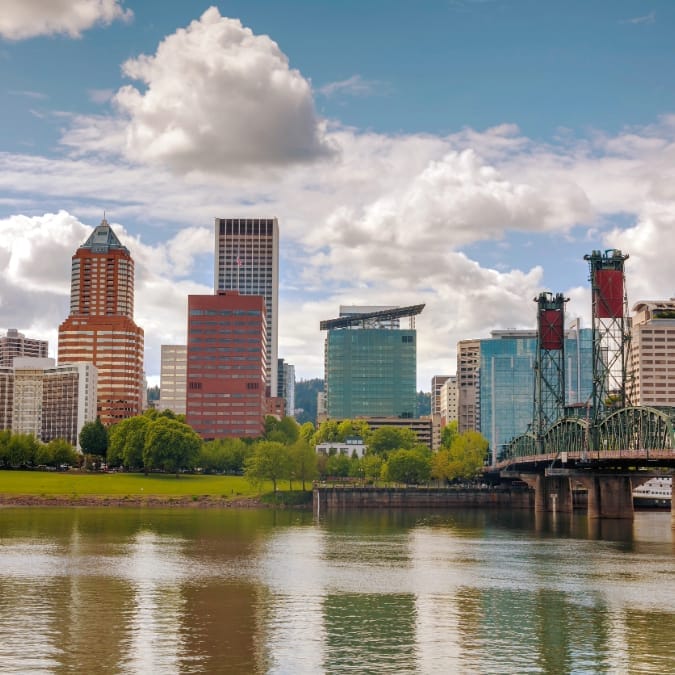Once considered havens for affordable living, certain cities across the United States have evolved from budget-friendly locales to high-priced urban centers. From the eclectic streets of Portland to the heart of country music in Nashville, these 13 formerly cheap places to live have undergone dramatic shifts in housing costs.
1. Portland, Oregon
Portland’s quirky charm and relatively low cost of living once attracted many newcomers and artists. However, the city’s popularity has caused housing prices to skyrocket, with neighborhoods like Pearl District and Alberta Arts District becoming unaffordable for many.
2. Nashville, Tennessee
Nashville’s rise as a cultural and economic hub has resulted in a surge in housing prices. Once affordable neighborhoods like East Nashville and 12 South have seen rapid gentrification and rising rents. According to Zillow, the median rent in Nashville for all property types is $2,236, which may be hard for the average worker to afford.
3. Boise, Idaho
Boise’s affordable housing and high quality of life once made it an attractive destination for families and young professionals. However, the city’s rapid growth and influx of out-of-state residents from California and Washington have led to soaring housing prices, particularly in neighborhoods like North End and Downtown Boise.
4. Raleigh, North Carolina
Raleigh, the capital city of North Carolina, offers a blend of Southern charm, thriving technology sectors, and a diverse culinary and cultural scene. Its position as part of the Research Triangle Region, alongside Durham and Chapel Hill, fosters a dynamic economy driven by technology, education, and healthcare.
However, housing prices in the city have surged as big tech companies like Apple have moved in and workers have flocked there. According to Realtor.com, the average listing price in the city is $515,000, nearly a 10% increase year-over-year.
5. Bend, Oregon
Nestled in the heart of Central Oregon, Bend was once a quaint town known for its outdoor recreational opportunities and affordable cost of living. However, the city’s popularity as a destination for retirees and remote workers has driven up housing costs, especially in neighborhoods like Old Bend and Westside. Zillow reports that the average home value in Bend is a whopping $736,000, up 4.2% from last year.
6. Santa Fe, New Mexico
Known for its rich culture and arts scene, Santa Fe was once an affordable destination for retirees and artists. However, the city’s popularity as a tourist destination and second home market has led to rising property prices, particularly in neighborhoods like Canyon Road and South Capitol. According to Realtor.com, the median listing price in Santa Fe has climbed to nearly $800,000, locking many people out of the real estate market due to unaffordability.
7. Charleston, South Carolina
Although the South is known for its affordable cost of living. Charleston is an exception. The city’s historic charm and coastal beauty have made it a popular destination for tourists and new residents alike. However, Charleston’s popularity has led to a surge in housing prices, particularly downtown and in the French Quarter.
The median listing price of homes in Charleston has reached $685,000, up 7.9% year-over-year. However, homes downtown regularly sell for $1 million according to Redfin, so it costs a pretty penny to live right in the middle of the action.
8. Chicago, Illinois
While certain neighborhoods in Chicago have always been expensive, areas like Logan Square and Wicker Park were once affordable options. However, the influx of flush young professionals and development projects have made these neighborhoods increasingly trendy and pricey.
The average monthly rent in Wicker Park is around $2,700. This can be tough for many Chicagoans to afford considering most landlords require you to earn 3X your rent payment.
9. San Francisco
San Francisco was once an affordable epicenter of hippie culture. However, strict zoning laws have caused a lack of real estate development, leading to housing shortages and rising costs. The area’s tech boom has further worsened this problem by drastically increasing demand for homes and apartments. Sadly San Francisco has transformed into one of the most expensive places to live in America, pushing many long-time residents out.
10. Brooklyn, New York
Once a haven for artists and young professionals seeking affordable rent, Brooklyn has experienced a massive surge in housing costs over the years. Areas like Williamsburg and Park Slope now boast some of the highest rents and property prices in the city due to rapid gentrification.
Areas of Williamsburg that used to be mainly industrial have transformed into luxury shopping districts featuring high-end stores and condominiums. For many long-time residents, Brooklyn has become unrecognizable from its humble beginnings.
11. Austin, Texas
Austin, Texas is known for its vibrant, quirky cultural scene, with diverse music, food, and art. The city used to have a manageable cost of living that was within reach for students, musicians, and young families. However, housing costs have continuously climbed, pushing some residents out. Austin was recently named the 5th most expensive city in the US for renters, proving that it’s no longer a cheap place to live.
12. Denver, Colorado
Denver’s booming economy, beautiful natural landscapes, and outdoor-centric lifestyle have made it a desirable place to live. However, this has led to a sharp increase in housing costs, especially in areas like LoDo and Highlands. Since 2022, the cost of owning a home in Denver has increased by 18%, but wages have not kept up with these rising expenses.
13. Boulder, Colorado
Boulder’s natural beauty and outdoor lifestyle have made it a sought-after destination, driving up housing costs. Neighborhoods like Pearl Street and Martin Acres, formerly cheap places to live for students and young professionals, have become increasingly expensive.
According to Redfin, the median home price in Boulder is a whopping $965,000. Unless you have a cool million to spend on your next home, it may be better to consider more affordable Colorado towns such as Pueblo and Grand Junction.
Cheap Places Don’t Always Stay That Way
Sadly, cheap places to live can evolve into expensive urban centers as more people discover them and relocate. As these formerly affordable cities continue to attract new residents and businesses, the low cost of living that once defined them has increasingly become a thing of the past.
While these transformations bring new economic and job opportunities, they also pose challenges for long-time residents and people seeking affordable housing. It’s crucial to address issues of housing affordability, equitable development, and community preservation to ensure that cities remain vibrant and inclusive spaces for all.
Read More
12 Realities of Living On The Edge of Poverty and Lower Middle Class
Reverse Boomerang: 11 Reasons Baby Boomers Are Moving In With Their Millennial Kids
Vicky Monroe is a freelance personal finance and lifestyle writer. When she’s not busy writing about her favorite money saving hacks or tinkering with her budget spreadsheets, she likes to travel, garden, and cook healthy vegetarian meals.



















